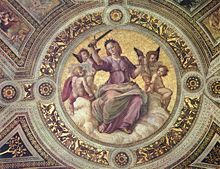
Raffaello Sanzio da Urbino, better known as Raphael, was an Italian painter and architect of the High Renaissance. His work is admired for its clarity of form, ease of composition, and visual achievement of the Neoplatonic ideal of human grandeur. Together with Leonardo da Vinci and Michelangelo, he forms the traditional trinity of great masters of that period.

The Apostolic Palace is the official residence of the pope, the head of the Catholic Church, located in Vatican City. It is also known as the Papal Palace, the Palace of the Vatican and the Vatican Palace. The Vatican itself refers to the building as the Palace of Sixtus V, in honor of Pope Sixtus V, who built most of the present form of the palace.
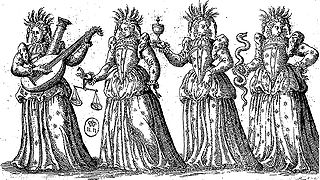
The cardinal virtues are four virtues of mind and character in both classical philosophy and Christian theology. They are prudence, justice, fortitude, and temperance. They form a virtue theory of ethics. The term cardinal comes from the Latin cardo (hinge); virtues are so called because they are regarded as the basic virtues required for a virtuous life.
In Christian tradition, the seven heavenly virtues combine the four cardinal virtues of prudence, justice, temperance, and fortitude with the three theological virtues of faith, hope, and charity.
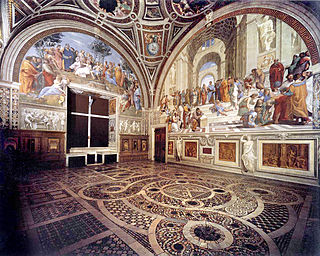
The four Raphael Rooms form a suite of reception rooms in the Apostolic Palace, now part of the Vatican Museums, in Vatican City. They are famous for their frescoes, painted by Raphael and his workshop. Together with Michelangelo's Sistine Chapel ceiling frescoes, they are the grand fresco sequences that mark the High Renaissance in Rome.

The Scrovegni Chapel, also known as the Arena Chapel, is a small church, adjacent to the Augustinian monastery, the Monastero degli Eremitani in Padua, region of Veneto, Italy. The chapel and monastery are now part of the complex of the Musei Civici di Padova.

A putto is a figure in a work of art depicted as a chubby male child, usually naked and sometimes winged. Originally limited to profane passions in symbolism, the putto came to represent the sacred cherub, and in Baroque art the putto came to represent the omnipresence of God. A putto representing a cupid is also called an amorino or amoretto.

The School of Athens is a fresco by the Italian Renaissance artist Raphael. The fresco was painted between 1509 and 1511 as a part of Raphael's commission to decorate the rooms now known as the Stanze di Raffaello, in the Apostolic Palace in the Vatican. It depicts a congregation of philosophers, mathematicians, and scientists from Ancient Greece, including Plato, Aristotle, Pythagoras, Archimedes, and Heraclitus. The Italian artists Leonardo da Vinci and Michelangelo are also featured in the painting, shown as Plato and Heraclitus respectively.

The Garvagh Madonna is an oil painting by the Italian Renaissance artist Raphael, dating to c. 1509–1510. It depicts the Virgin, the Christ Child and the infant John the Baptist, and is one of many paintings by Raphael with this trio. It is from early in the artist's third, or Roman period, in which distinctive changes are seen from his Umbrian or Florentine period in style and use of colour, with the introduction of more natural subjects and settings.

The Disputation of the Sacrament, or Disputa, is a painting by the Italian Renaissance artist Raphael. It was painted between 1509 and 1510 as the first part of Raphael's commission to decorate with frescoes the rooms that are now known as the Stanze di Raffaello, in the Apostolic Palace in the Vatican. At the time, this room was known as the Stanza della Segnatura, and was the private papal library where the supreme papal tribunal met.

The Parnassus is a fresco painting by the Italian High Renaissance artist Raphael in the Raphael Rooms, in the Palace of the Vatican in Rome, painted at the commission of Pope Julius II.

The Fire in the Borgo is a painting created by the workshop of the Italian Renaissance artist Raphael between 1514 and 1517. Though it is assumed that Raphael did make the designs for the complex composition, the fresco was most likely painted by his assistant Giulio Romano. The painting was part of Raphael's commission to decorate the rooms that are now known as the Stanze di Raffaello, in the Apostolic Palace in the Vatican. It depicts Pope Leo IV halting a fire in 847 with a benediction from a balcony in front of the Old St. Peter's Basilica. The mural lends its name to the Stanza dell'incendio del Borgo.

The Mass at Bolsena is a painting by the Italian renaissance artist Raphael. It was painted between 1512 and 1514 as part of Raphael's commission to decorate with frescoes the rooms that are now known as the Raphael Rooms, in the Apostolic Palace in the Vatican. It is located in the Stanza di Eliodoro, which is named after The Expulsion of Heliodorus from the Temple.

The Coronation of Charlemagne is a painting by the workshop of the Italian Renaissance artist Raphael. Though it is believed that Raphael did make the designs for the composition, the fresco was probably painted by Gianfrancesco Penni. The painting was part of Raphael's commission to decorate the rooms that are now known as the Stanze di Raffaello, in the Apostolic Palace in the Vatican. It is located in the room that was named after The Fire in the Borgo, the Stanza dell'incendio del Borgo.
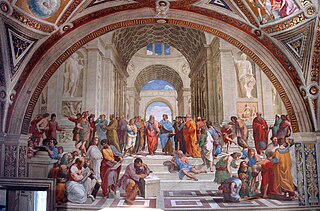
Pope Julius II, commissioned a series of highly influential art and architecture projects in the Vatican. The painting of the Sistine Chapel ceiling by Michelangelo and of various rooms by Raphael in the Apostolic Palace are considered among the masterworks that mark the High Renaissance in Rome. His decision to rebuild St Peter's led to the construction of the present basilica.
Events from the year 1511 in art.

The Stufetta del cardinal Bibbiena is a small room on the third floor of the Apostolic Palace in the Vatican, which is decorated with a cycle of erotic frescoes painted in 1516 by Raphael. The frescos depict mythological scenes from Ovid and Maurus Servius Honoratus, in an antique style echoing Ancient Roman interior décor of the Domus Aurea which had also inspired the decoration of the Raphael Rooms and the Vatican loggias.

Tommaso Inghirami was a Renaissance humanist and orator. He was prefect of the Vatican Library for several years and secretary of the Fifth Lateran Council.

The Scuola Grande dei Carmini is a confraternity building in Venice, Italy. It is located in the sestiere of Dorsoduro, before Campo dei Carmini and Campo Santa Margherita, upon which its facade looks. It stands, separated by an alley, to the northeast of the church of Santa Maria dei Carmini.
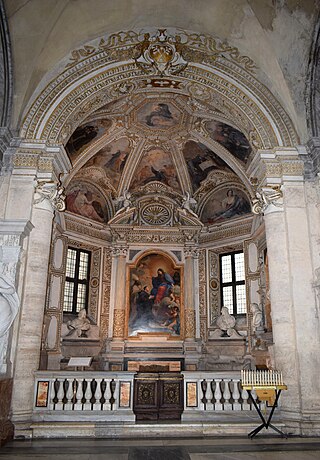
The Mellini or Saint Nicholas of Tolentino Chapel is the third chapel on the left-hand side of the nave in the Church of Santa Maria del Popolo in Rome. The chapel contains several funeral monuments of the members of the Mellini family among them the works of Alessandro Algardi and Pierre-Étienne Monnot.

